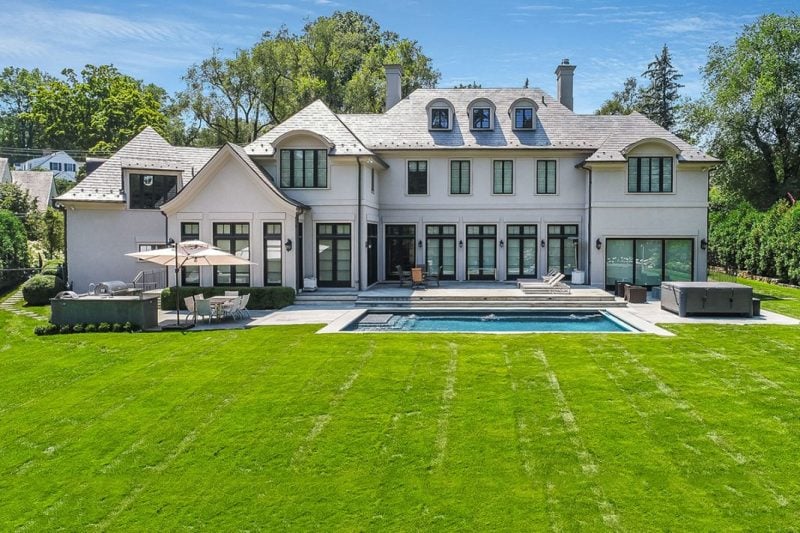The 30 Best Places to Live in Wisconsin: Top Cities and Towns
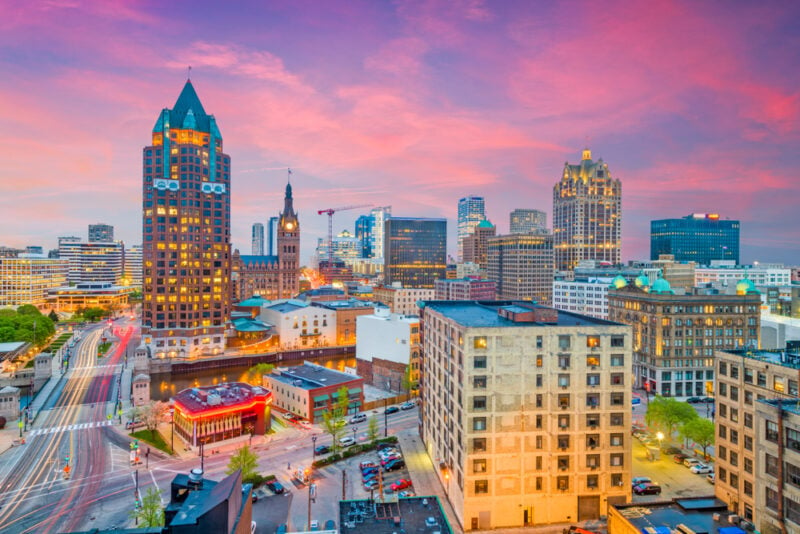
Wisconsin offers residents a unique combination of affordable living costs, strong communities, and diverse lifestyle options across its cities and towns.
From major metropolitan areas like Milwaukee and Madison to charming smaller communities such as Cedarburg and Mount Horeb, the state provides numerous options for people seeking quality places to call home.
This comprehensive guide examines thirty of Wisconsin’s top-rated communities, evaluating factors such as cost of living, employment opportunities, educational quality, and recreational amenities to help potential residents make informed decisions about where to settle.
Each location presents distinct advantages, whether someone prioritizes urban amenities, suburban comfort, or small-town charm, making Wisconsin an attractive destination for families, young professionals, and retirees alike.
Here are the 30 best places to live in Wisconsin:
30. Fond du Lac
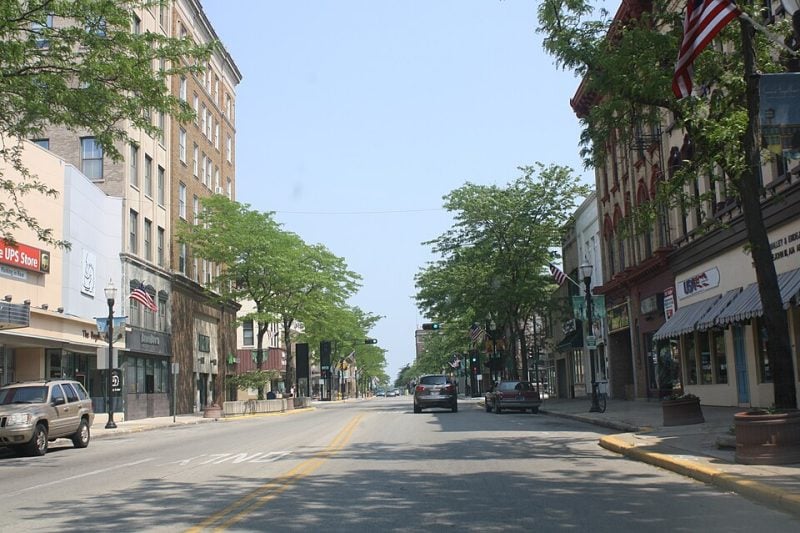
Fond du Lac sits at the southern shore of Lake Winnebago, offering residents scenic lakefront living. The city has a population of 44,491 and provides a dense suburban atmosphere.
Home prices in Fond du Lac remain below Wisconsin’s state average of $220,185. Most residents own their homes rather than rent.
The University of Wisconsin operates a local campus here, providing four-year degree programs. Public schools in the area perform above average compared to state standards.
Residents enjoy abundant recreational opportunities during both summer and winter months. The city features numerous parks and bars throughout the community.
Lake Winnebago provides water-based activities like boating and fishing. The downtown area offers local shops and dining options for residents.
Fond du Lac attracts families and young professionals seeking affordable housing near natural amenities. The community tends to lean conservative politically.
29. Kenosha
Kenosha sits on Lake Michigan’s shores in southeastern Wisconsin, offering residents scenic waterfront views and recreational opportunities. The city provides convenient access to both Milwaukee and Chicago, positioned just 30 miles and 65 miles away respectively.
Housing costs remain affordable compared to Wisconsin’s state average of $220,185. The median household income reaches $56,113 annually, though this falls below the national median.
Carol Beach attracts residents with its lakefront location and mix of older and newer homes. Strawberry Creek appeals to families seeking upscale living with golf course amenities and modern housing options.
Downtown Kenosha features historic buildings and ongoing revitalization efforts. The area provides urban amenities while maintaining small-city charm.
Outdoor enthusiasts enjoy Petrifying Springs Park and North Beach for swimming, fishing, and other recreational activities. The city’s location along Interstate 94 and near Metra train service facilitates commuting to larger metropolitan areas.
28. Milwaukee

Milwaukee stands as Wisconsin’s largest city and economic hub. The city offers diverse neighborhoods ranging from historic areas to modern developments.
Downtown Milwaukee features the Historic Third Ward with its cobblestone streets and converted warehouses. The lakefront provides scenic views of Lake Michigan along with parks and recreational opportunities.
Housing costs in Milwaukee remain below national averages. The city supports a mix of young professionals, families, and students from local universities.
Milwaukee’s brewing heritage continues today with numerous craft breweries. The food scene includes everything from traditional bratwurst to contemporary dining establishments.
Public transportation connects most neighborhoods through bus routes. The city maintains several cultural attractions including museums, theaters, and music venues.
Crime rates vary significantly by neighborhood. Residents should research specific areas before choosing where to live within the city limits.
27. Madison
Madison serves as Wisconsin’s state capital and home to the University of Wisconsin. The city sits between two lakes, providing scenic waterfront views and recreational opportunities.
Residents enjoy access to numerous parks, cultural attractions, and outdoor activities. The university brings energy and educational resources to the community.
Madison receives high marks for affordability with strong healthcare systems. The city offers walkable neighborhoods and bike-friendly infrastructure.
The downtown area features restaurants, shops, and entertainment venues. State government and the university provide stable employment opportunities for residents.
Housing options range from historic neighborhoods to modern developments. The city attracts both young professionals and families seeking quality schools and amenities.
26. Green Bay
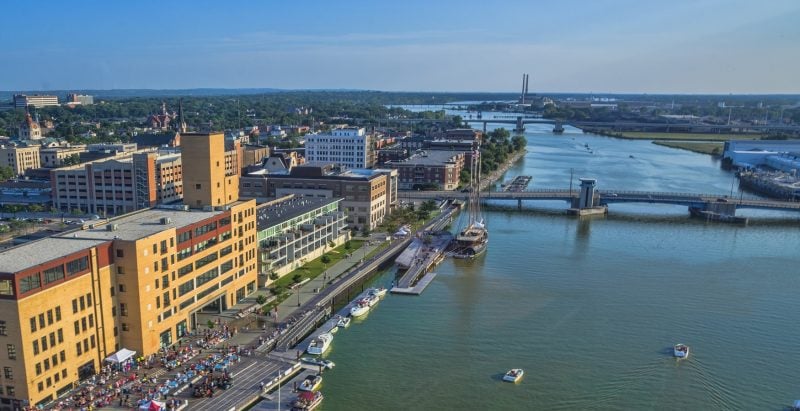
Green Bay earned recognition as Wisconsin’s best place to live according to U.S. News & World Report’s 2025-2026 rankings. The city placed 12th nationally in the Best Places to Live category.
Located in Brown County, Green Bay offers residents a vibrant community with diverse cultural attractions. The National Railroad Museum and Neville Public Museum provide educational experiences for families.
Housing costs remain affordable compared to state averages. Green Bay home prices are less expensive than Wisconsin’s average of $220,185, making homeownership accessible for many residents.
The city made Livability.com’s 2025 Top 100 Best Places to Live list alongside Appleton. This recognition highlights Green Bay’s appeal among small to mid-sized cities across the United States.
Outdoor recreation includes Bay Beach Amusement Park and various waterfront activities along Green Bay’s shoreline. The city balances urban amenities with natural attractions.
25. Menomonee Falls
Menomonee Falls ranks as one of Wisconsin’s most livable communities. The suburb sits 30 minutes from Milwaukee in Waukesha County.
The city has earned national recognition for its quality of life. Money Magazine ranked it the 15th Best Place to Live in America in 2020.
Home prices exceed the state average of $220,185. Most residents own their homes in this dense suburban community.
The downtown area offers walkable streets filled with shops and restaurants. Mill Pond Park hosts summer farmers markets and weekly beer gardens with live music.
Menomonee Falls scores highly for safety with low violent crime rates. The public school system receives strong ratings from residents.
Kohl’s department store maintains its headquarters here, providing thousands of local jobs. The city offers numerous parks throughout the community.
24. Sheboygan
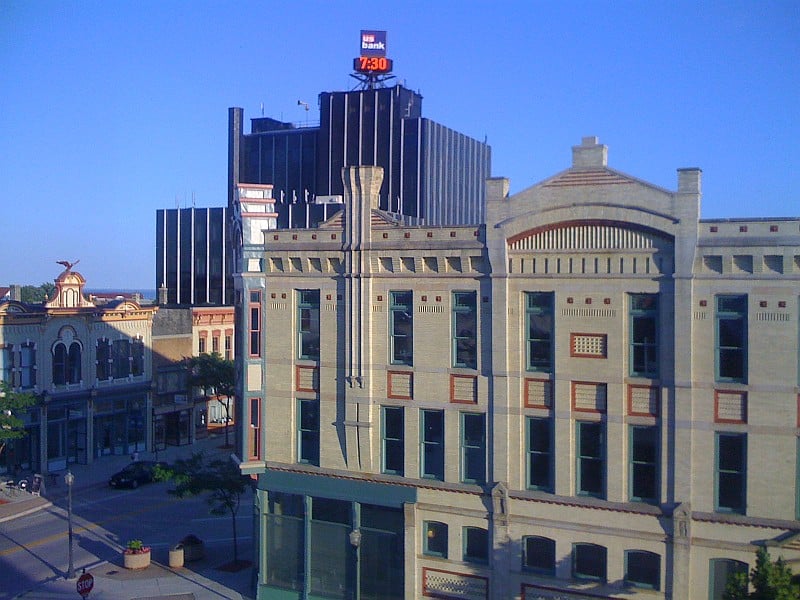
Sheboygan ranks among Wisconsin’s top cities for livability, placing 11th overall in the state. The city offers residents low crime rates and good air quality along Lake Michigan’s shoreline.
The typical household earns $52,088 annually. Sheboygan’s poverty rate sits at 10.5%, which is 25% lower than the national average.
Downtown Sheboygan provides urban amenities with restaurants and shops. The Kohler area features luxury amenities and world-class golf courses for residents seeking upscale living.
Sheboygan County offers over 3,000 job openings across various industries. The city scored high marks for walkable neighborhoods and healthcare access in recent livability studies.
Families appreciate the excellent schools in areas like Pigeon River. Lake Michigan provides numerous recreational opportunities including boating, fishing, and waterfront activities year-round.
23. Racine
Racine sits along Lake Michigan’s western shore with a population of approximately 77,000 residents. The city combines historic charm with modern amenities in southeastern Wisconsin.
The metropolitan area offers access to Lake Michigan’s coastline along with numerous parks and trails. Residents enjoy shopping areas, art galleries, and museums throughout the community.
Several neighborhoods stand out for different reasons. Towerview features well-preserved historic homes and strong community connections. West Racine provides diverse housing options alongside local businesses.
Colonial Village attracts families with good schools and community parks. Windpoint offers upscale lakeside homes with a small-town atmosphere.
The local economy centers on manufacturing and healthcare industries. Racine County provides both urban and rural landscapes for residents seeking variety.
Housing costs vary significantly between neighborhoods, creating options for different income levels. The city experiences a continental climate with warm summers and cold, snowy winters.
22. Neenah
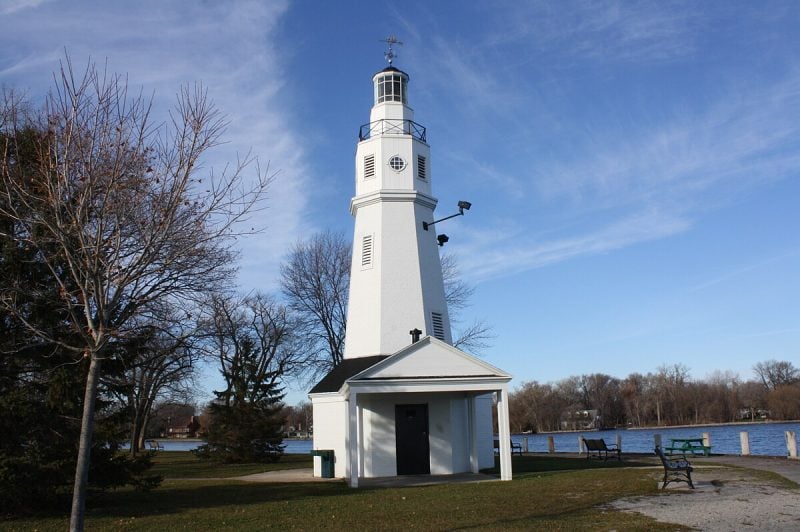
Neenah ranks as one of Wisconsin’s most livable communities with an impressive livability score of 87 out of 100. The city consistently receives high marks for education quality and economic growth.
Located in Winnebago County, Neenah offers picturesque landscapes and rich historical attractions. Residents enjoy access to outdoor recreational activities and well-maintained parks throughout the area.
The community maintains a low crime rate that contributes to its high quality of life standards. Families appreciate the safe neighborhoods and strong public school system.
Neenah’s housing market varies significantly across different neighborhoods. Home values reflect the desirability of specific areas within the city.
The city provides diverse recreational opportunities from museums to state parks. Local businesses and unique shops contribute to Neenah’s vibrant downtown atmosphere.
21. West Bend
West Bend sits northeast of Milwaukee in Washington County with approximately 31,000 residents. This makes it the largest city in Washington County and part of the Greater Milwaukee Area.
The city earned an overall livability score of 72 out of 100, ranking as the 65th best place to live in Wisconsin. West Bend offers a suburban atmosphere combined with rural charm.
Home prices in West Bend align closely with Wisconsin’s state average of $220,185. The housing market reflects steady demand from residents seeking quality neighborhoods.
The city provides access to good public schools and maintains reasonable crime rates. Local amenities support daily needs while proximity to Milwaukee expands employment and entertainment options.
West Bend attracts families and professionals who value small-city living with big-city access.
20. Hudson

Hudson sits along the St. Croix River in St. Croix County with over 13,000 residents. The city earned recognition as the 6th best place to live in Wisconsin out of 221 locations.
Known as the “Gateway to the Twin Cities,” Hudson offers a safe living environment with picturesque river views. The community maintains a dense suburban feel where most residents own their homes.
Hudson’s median household income of $74,207 exceeds the national average of $67,500. The poverty rate stands at 6.8%, which is 51% lower than the national average.
The city features numerous parks and recreational opportunities. Home prices in Hudson are higher than Wisconsin’s state average of $220,185, reflecting the area’s desirability and quality of life.
19. Greendale
Greendale stands out as one of Wisconsin’s most desirable communities, ranking 16th best place to live in the state. This Milwaukee suburb houses 14,656 residents and earned a livability score of 84 out of 100.
The village offers a dense suburban atmosphere where most residents own their homes. Founded as a planned community in the 1930s, Greendale features distinctive architecture blending traditional homes with modern developments.
Residents enjoy access to numerous bars, restaurants, coffee shops, and parks throughout the community. The typical household earns $74,661 annually, well above the national median of $67,500.
Greendale maintains a low poverty rate of 4.6%, which is 67% lower than the national average. The community provides excellent schools and convenient transportation access to the greater Milwaukee area.
Home prices exceed Wisconsin’s state average of $220,185, reflecting the area’s desirability and strong market demand.
18. La Crosse
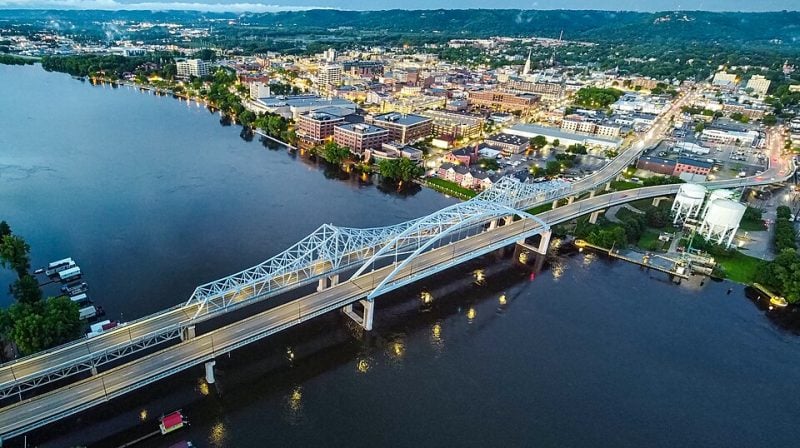
La Crosse sits along the Mississippi River in western Wisconsin. The city offers affordable housing compared to state averages and maintains a strong job market with competitive wages.
The downtown area features numerous art galleries and small theaters. The La Crosse Symphony Orchestra provides cultural entertainment for residents.
Outdoor enthusiasts enjoy excellent freshwater fishing opportunities along the river. The surrounding bluffs create scenic views throughout the city.
Two notable neighborhoods include Grandview-Emerson near the University of Wisconsin-La Crosse and Bluffside with river views. The city provides quality healthcare systems and educational options.
La Crosse has received recognition as one of the best affordable places to live in recent national rankings. The combination of lower living costs and available amenities attracts new residents to the area.
17. Wausau
Wausau ranks among Wisconsin’s most livable cities, placing 73rd out of 410 best places to live statewide. The city offers a strong community atmosphere with friendly residents and solid family-oriented neighborhoods.
Housing costs remain reasonable compared to national averages. The median household income sits at $47,438, though this falls below the national median of $67,500.
The city provides good housing options across various neighborhoods. Home values vary significantly throughout different areas, giving residents multiple price points to consider.
Wausau maintains lower crime rates in many neighborhoods. The community feel remains strong, typical of smaller Wisconsin cities.
Winter weather requires tolerance from residents. Those who adapt find the city offers substantial amenities and quality of life benefits for families and retirees alike.
16. Appleton
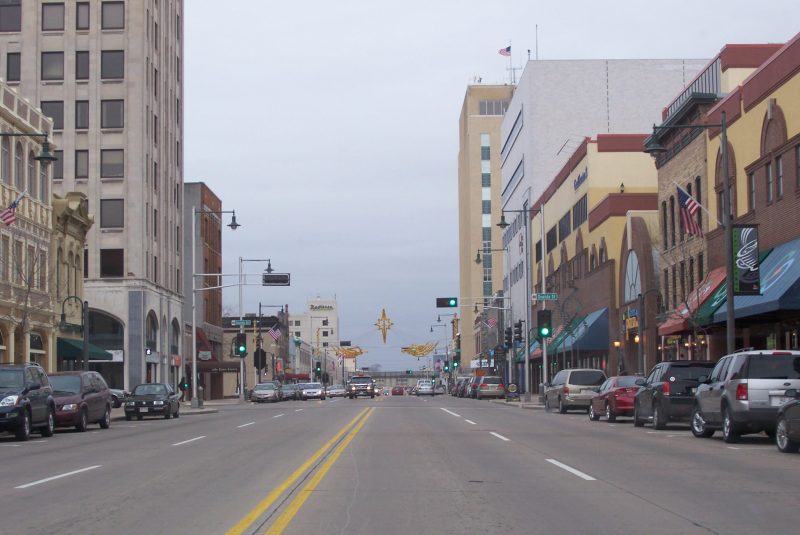
Appleton sits along the Fox River in Outagamie County with a population of 74,873 residents. The city serves as the cultural heart of the Fox Cities region.
Most residents own their homes in this dense suburban community. The downtown area features clean streets and sits near Lake Winnebago.
The city offers numerous bars, restaurants, and parks for entertainment. A performing arts complex brings Broadway shows to the region throughout the year.
Appleton ranks as one of Wisconsin’s best places to live according to multiple studies. Only one Wisconsin city ranks higher on national best places lists.
The community provides access to quality public schools and reasonable cost of living. Neighborhoods spread east and northeast from downtown until reaching surrounding farmland.
15. Verona
Verona ranks among Wisconsin’s top communities with a population of approximately 13,000 residents. The city sits about 20 minutes from downtown Madison in Dane County.
The community boasts exceptional schools that earn high ratings statewide. Families and young professionals choose Verona for its educational opportunities and quality of life.
Verona’s median household income reaches $96,056, significantly above the national average of $67,500. The poverty rate stands at just 2%, well below national levels.
Housing costs exceed Wisconsin’s state average of $220,185. The higher prices reflect strong demand for this desirable location.
The city calls itself “Hometown USA” with a charming main street atmosphere. Verona combines small-town character with suburban amenities and proximity to Madison’s employment opportunities.
Outdoor activities and recreational options contribute to the area’s appeal for residents of all ages.
14. Mount Horeb
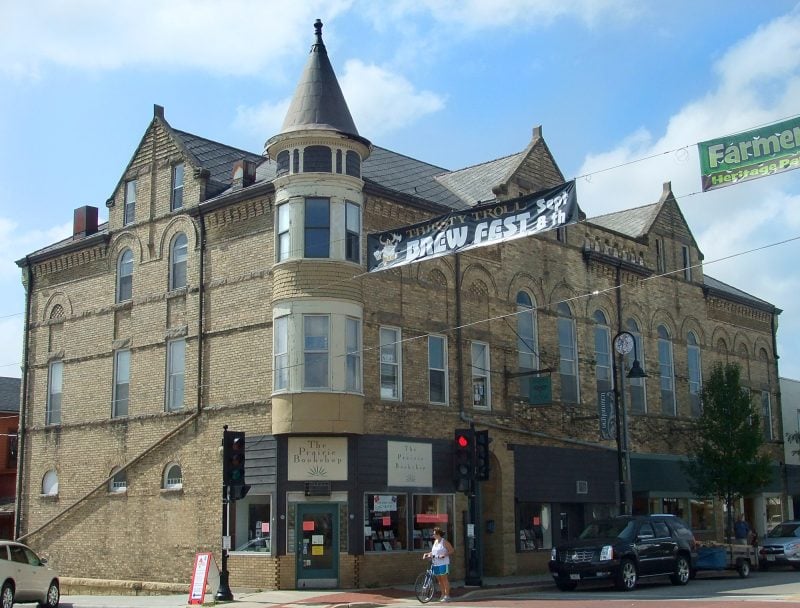
Mount Horeb sits 18 miles from Madison in Dane County. This charming town has a population of 7,719 residents and offers small-town appeal with suburban convenience.
The community provides a sparse suburban feel where most residents own their homes. Mount Horeb features abundant parks and bars that serve as gathering places for locals.
Home prices in Mount Horeb exceed Wisconsin’s state average of $220,185. The town ranks among Wisconsin’s better places to live according to multiple housing value assessments.
Mount Horeb’s downtown area maintains its charm while the community benefits from proximity to Madison’s urban amenities. The town combines beautiful landscapes with rich cultural heritage.
Families and young professionals find Mount Horeb appealing for its welcoming atmosphere and strong community spirit. The location offers easy access to larger city resources while maintaining small-town character.
13. Grafton
Grafton stands as one of Wisconsin’s premier suburban communities. The city sits in Ozaukee County with a population of approximately 12,000 residents.
This Milwaukee suburb offers residents a dense suburban atmosphere. Most people own their homes rather than rent. The community attracts both families and young professionals.
Grafton earns high marks for quality of life indicators. The poverty rate sits at just 4.2%, significantly below the national average. Typical household income reaches $74,918, exceeding the national median.
The city scores well in multiple categories. Crime and safety rates earn strong ratings. Educational quality receives high marks from residents and rating services.
Public schools maintain excellent reputations throughout the district. Housing options provide good value for buyers. The community maintains a tight-knit, friendly atmosphere while offering access to nearby metropolitan amenities.
12. De Pere
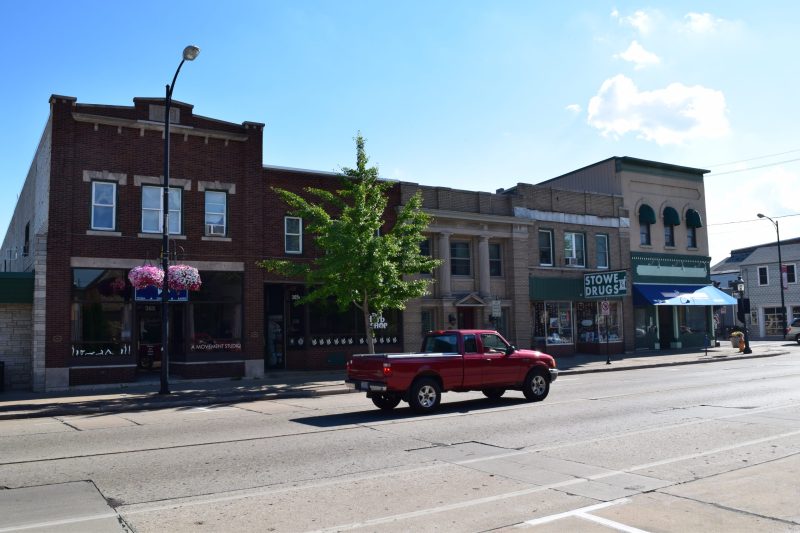
De Pere ranks as the third best place to live in Wisconsin according to BestPlaces rankings. The city earned an A+ rating with an overall score of 79.
This Brown County community houses 25,368 residents in a dense suburban setting. Most residents own their homes, creating stable neighborhoods throughout the area.
The city offers low crime rates and high median household incomes. Quality healthcare access adds to the community’s appeal for families and retirees.
De Pere provides numerous restaurants and parks for residents. Rivers and trails create opportunities for outdoor activities year-round.
The location near Green Bay gives residents access to larger city amenities. Home prices exceed Wisconsin’s state average of $220,185, reflecting the area’s desirability.
11. Germantown
Germantown sits northwest of Milwaukee in Washington County with a population of 20,940. The city ranks as one of Wisconsin’s best places to live due to its safety, affordability, and excellent amenities.
The community offers a sparse suburban feel where most residents own their homes. Public schools receive an A+ rating, contributing to the area’s family-friendly reputation.
Home prices exceed Wisconsin’s state average of $220,185, reflecting the desirability of the area. Residents enjoy access to numerous bars and parks throughout the city.
Notable landmarks include North Lake Park and Firemen’s Park, which features rides and tour opportunities. The city hosts annual festivals, including Polka Fest each September.
Germantown ranks fourth in the state for highest median income according to census data. The combination of strong schools, recreational opportunities, and proximity to Milwaukee makes it attractive to families and professionals.
10. Middleton
Middleton consistently ranks among Wisconsin’s top places to live. Fortune magazine ranked the city 18th nationally on its Best Places to Live for Families list in 2024.
Known as “the Good Neighbor City,” Middleton sits in the Madison metropolitan area. The community offers residents lower tax rates compared to many neighboring areas.
The city attracts families with its friendly atmosphere and strong community connections. Educational opportunities and local amenities contribute to its high livability ratings.
Home prices in Middleton exceed the state average of $220,185. The higher cost reflects strong demand and desirable neighborhood characteristics.
Multiple national publications recognize Middleton’s quality of life. The city’s suburban setting provides access to Madison’s employment opportunities while maintaining a small-town feel.
Middleton continues growing while preserving its community-focused identity. Residents benefit from well-maintained neighborhoods and local services.
9. Sun Prairie
Sun Prairie stands out as a highly desirable suburb of Madison with a population of 36,455 residents. The city consistently earns recognition for its exceptional livability.
Money Magazine named Sun Prairie one of the “Best Places to Live in America” in 2020, ranking it 40th nationally. The city earned a livability score of 75 out of 100 points according to BestPlaces rankings.
Most residents own their homes in this dense suburban community. Sun Prairie offers numerous parks and outdoor recreational activities including fishing and camping opportunities.
The city maintains a competitive cost of living score of 74 out of 100. Home prices exceed Wisconsin’s state average of $220,185, reflecting the area’s desirability.
Sun Prairie hosts various cultural events throughout the year, including its notable Groundhog Day celebration. The community benefits from a healthy local economy and proximity to Madison’s amenities.
8. Wauwatosa
Wauwatosa sits just west of Milwaukee along the Menomonee River. The city consistently ranks among Wisconsin’s top places to live.
Niche ranked Wauwatosa as the 3rd best suburb for young professionals in Wisconsin. The city also placed 10th among all Wisconsin suburbs and 11th statewide for best places to live.
Housing prices in Wauwatosa exceed the Wisconsin average of $220,185. The city ranks in the top 10% nationally for housing affordability and quality according to BestPlaces.
Wauwatosa offers safe neighborhoods and well-maintained parks throughout the community. Residents enjoy abundant outdoor recreation including golfing, biking, and fishing opportunities.
The city provides excellent schools and strong community amenities. Its proximity to Milwaukee gives residents access to urban conveniences while maintaining a suburban atmosphere.
7. Eau Claire
Eau Claire stands out as Wisconsin’s premier destination for quality living. U.S. News & World Report ranked it the top place to live in Wisconsin and 49th nationally.
The city offers a balanced mix of small-town charm and urban amenities. Downtown features numerous restaurants, cafes, music venues, and unique shops that create a vibrant atmosphere.
Residents enjoy access to extensive parks, trails, and recreation centers. The area provides abundant outdoor activities throughout the year.
Eau Claire excels in multiple quality-of-life categories. The city scores well in affordability, job opportunities, education, healthcare quality, and safety ratings.
Housing costs remain reasonable, with home prices similar to Wisconsin’s state average. The strong local job market supports economic stability for residents.
The community benefits from quality educational institutions and healthcare facilities. These factors contribute to Eau Claire’s reputation as an exceptional place to call home.
6. Waunakee
Waunakee stands out as one of Wisconsin’s premier suburban communities. This Dane County town serves as a sought-after suburb of Madison with a population of approximately 14,927 residents.
The community offers a dense suburban atmosphere where most residents own their homes. Families particularly appreciate the abundance of parks and recreational facilities throughout the area.
Housing costs in Waunakee exceed Wisconsin’s state average of $220,185. The higher prices reflect strong market demand and desirable neighborhood characteristics.
Multiple ranking services recognize Waunakee as one of Wisconsin’s best places to live. These evaluations consider factors like cost of living, crime rates, education quality, and housing affordability.
The town provides residents with numerous bars and entertainment options alongside its family-friendly amenities. Its location in Dane County offers convenient access to Madison’s employment opportunities and urban services.
5. Mequon
Mequon stands out as one of Wisconsin’s premier suburban communities. This Ozaukee County city ranks third among the best places to retire in Wisconsin and fifth among the state’s best suburbs.
The city offers residents access to five golf courses and scenic views along the Milwaukee River. Its convenient location provides easy commuting access to Milwaukee while maintaining a peaceful suburban atmosphere.
Mequon’s school system ranks among Wisconsin’s finest, featuring exceptionally high graduation rates. The community attracts families, professionals, and retirees seeking quality education options.
Home prices in Mequon exceed Wisconsin’s state average of $220,185, reflecting the area’s desirability. The city provides a sparse suburban feel where most residents own their homes.
The community features numerous coffee shops and parks throughout its neighborhoods. Mequon successfully combines rural charm with modern suburban amenities.
4. Oconomowoc
Oconomowoc sits in Waukesha County between Lake Oconomowoc and the Oconomowoc River. The city offers a blend of suburban comfort and lakeside living.
The community features a historic downtown area with local shops and restaurants. Residents enjoy access to water activities and recreational opportunities throughout the year.
Housing costs in Oconomowoc are higher than the Wisconsin state average of $220,185. The market reflects strong demand for homes in this desirable location.
The city ranks well for employment opportunities and education quality. Crime rates remain low compared to other Wisconsin communities.
Oconomowoc attracts young professionals and retirees alike. The area ranks 20th out of 266 for best retirement locations in Wisconsin.
The community maintains an active social environment with various local events and amenities. Public schools serve families well in this lakeside setting.
3. Cedarburg
Cedarburg stands out as one of Wisconsin’s premier residential destinations. This small city in Ozaukee County balances rural charm with urban conveniences.
The community ranks 12th out of 266 Wisconsin places for best public schools. Families particularly benefit from the strong educational system and safe neighborhoods.
Cedarburg earned recognition as the 12th best suburb for raising a family in Wisconsin. The city maintains a friendly atmosphere that appeals to residents of all ages.
Home prices exceed Wisconsin’s state average of $220,185, reflecting high demand for the area. The higher costs correspond with quality amenities and desirable neighborhood features.
The historic downtown area features unique shops and restaurants. Cedarburg’s quaint character attracts both residents and visitors throughout the year.
Multiple ranking organizations consistently place Cedarburg among Wisconsin’s top communities for livability and family life.
2. Brookfield
Brookfield ranks as Wisconsin’s second-best small city according to WalletHub rankings. This Milwaukee suburb houses approximately 41,000 residents and consistently earns recognition for its exceptional quality of life.
The city excels in economic stability and maintains strong financial health. Brookfield ranks first among Wisconsin’s best suburbs and second in places with top public schools statewide.
Home prices in Brookfield exceed Wisconsin’s state average of $220,185. The higher costs reflect the area’s desirability and premium amenities that attract families and professionals.
Educational opportunities stand out as a major draw. The community prioritizes academic excellence through well-funded school systems and educational resources.
Brookfield offers low crime rates and safe neighborhoods throughout the city. Residents benefit from excellent municipal services and well-maintained infrastructure that supports daily life.
1. Whitefish Bay
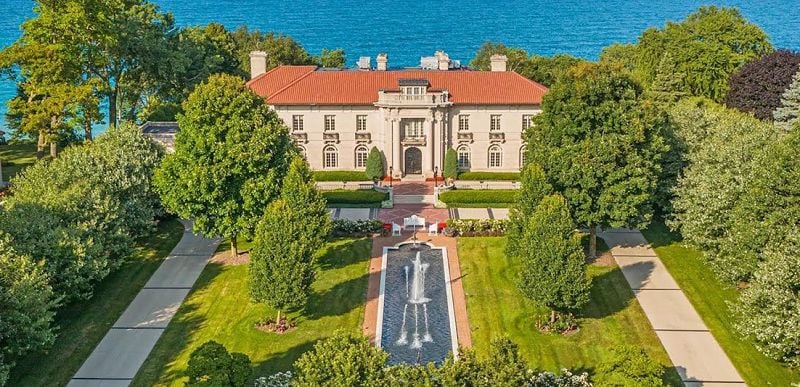
Whitefish Bay ranks as Wisconsin’s top place to live according to recent Niche.com rankings. This Milwaukee suburb houses 14,750 residents in Milwaukee County.
The city offers a sparse suburban atmosphere where most residents own their homes. Numerous restaurants, coffee shops, and parks provide local amenities for daily life.
Whitefish Bay sits east of Milwaukee with natural attractions like Klode Park. The park features beach access and fishing opportunities along Lake Michigan.
Home prices exceed Wisconsin’s state average of $220,185. The higher cost reflects the area’s desirability and quality of life factors.
Sixteen of Wisconsin’s top twenty places to live are located in the Milwaukee metropolitan area. Whitefish Bay leads this group, surpassing previous top-ranked Elm Grove.
The community attracts tourists through events like Fish Day. Its location provides access to both urban Milwaukee amenities and Great Lakes recreational activities.
Factors That Influence Livability in Wisconsin
Wisconsin’s livability rankings consider multiple critical factors that directly impact residents’ daily lives. Crime statistics, educational performance, housing affordability, and job market strength serve as primary indicators when evaluating communities across the state.
Safety and Crime Rates
Crime rates significantly impact property values and quality of life across Wisconsin communities. Cities with lower violent crime rates typically rank higher in livability studies.
Wisconsin maintains below-average crime rates compared to national statistics. The state’s violent crime rate sits at approximately 3.0 incidents per 1,000 residents, which is notably lower than the national average of 4.0.
Property crime varies considerably between urban and rural areas. Milwaukee experiences higher crime rates due to its urban density, while smaller communities like Hudson and Middleton report significantly lower incidents.
Key Crime Factors:
- Violent crime rates per capita
- Property crime statistics
- Police response times
- Community safety programs
Rural Wisconsin counties often report the lowest crime statistics statewide. These areas benefit from close-knit communities and lower population density.
Education Quality
School district performance directly influences family relocation decisions and property values throughout Wisconsin. High-performing districts attract families and contribute to community stability.
Wisconsin’s public schools receive mixed ratings across different regions. The state allocates approximately $12,000 per pupil annually, though funding varies significantly between districts.
Suburban districts consistently outperform urban counterparts in standardized testing. Communities like Mequon-Thiensville and Elm Grove maintain top-tier academic ratings.
Educational Metrics Include:
- Test scores and graduation rates
- Teacher-to-student ratios
- College preparation programs
- Special education services
Madison benefits from proximity to the University of Wisconsin system. This creates educational opportunities and contributes to the area’s intellectual atmosphere.
Cost of Living
Housing costs represent the largest expense factor for Wisconsin residents. Median home prices vary dramatically between metropolitan and rural areas.
Wisconsin’s overall cost of living sits approximately 8% below the national average. Housing costs remain the primary driver of regional differences across the state.
Madison and Milwaukee metro areas command the highest housing prices. Rural counties offer significantly lower costs but may lack certain amenities and employment opportunities.
Major Cost Components:
- Housing and rental markets
- Utilities and transportation
- Healthcare expenses
- State and local taxes
Property taxes in Wisconsin average 1.85% of assessed value. This rate impacts long-term homeownership costs across all communities.
Employment Opportunities
Job market strength determines long-term community sustainability and attracts new residents. Wisconsin’s economy relies heavily on manufacturing, healthcare, and agriculture.
The state’s unemployment rate typically tracks close to national averages. Urban areas offer more diverse employment options, while rural regions depend on specific industries.
Madison leads in job growth due to government employment and technology sectors. Milwaukee provides manufacturing and healthcare opportunities for skilled workers.
Employment Factors:
- Job growth rates
- Industry diversity
- Average wage levels
- Career advancement opportunities
Healthcare and education sectors provide stable employment statewide. These industries offer consistent opportunities regardless of economic cycles.
Lifestyle and Community Considerations
Wisconsin communities offer diverse recreational opportunities from Great Lakes waterfront activities to extensive trail systems, while maintaining strong cultural institutions and accessible healthcare networks. The state’s lifestyle centers around outdoor recreation, community festivals, and proximity to quality medical facilities.
Recreation and Outdoor Activities
Wisconsin provides year-round outdoor recreation with over 15,000 lakes and 84,000 miles of rivers and streams. The state maintains more than 600,000 acres of state parks and forests for hiking, camping, and wildlife viewing.
Winter Activities:
- Cross-country skiing on groomed trails
- Ice fishing on frozen lakes
- Snowmobiling through designated corridors
- Winter festivals in communities like Lake Geneva
Summer Recreation:
- Boating and swimming on Lake Michigan and Lake Superior
- Fishing for walleye, bass, and trout
- Cycling on converted rail trails
- State fair activities in West Allis
Door County offers scenic coastal drives and cherry orchards. The Wisconsin Dells provides water parks and natural sandstone formations. Cities like Madison feature extensive bike path networks connecting neighborhoods to downtown areas.
Cultural Attractions
Wisconsin communities maintain strong cultural identities through museums, theaters, and annual celebrations. Milwaukee houses the Harley-Davidson Museum and Milwaukee Art Museum with its distinctive wing-like architecture.
Cultural Venues:
- Green Bay Packers Hall of Fame in Green Bay
- Wisconsin Historical Museum in Madison
- Overture Center for the Arts in Madison
- Pabst Theater in Milwaukee
Many towns host ethnic festivals celebrating German, Polish, and Scandinavian heritage. Summerfest in Milwaukee attracts national music acts each summer. Smaller communities organize harvest festivals, craft fairs, and farmers markets.
The state supports local theater groups and community orchestras. Universities in Madison, Milwaukee, and other cities contribute cultural programming through concerts, lectures, and sporting events.
Healthcare Accessibility
Wisconsin maintains quality healthcare systems with major medical centers located throughout the state. The University of Wisconsin Hospital in Madison provides specialized treatments and research facilities.
Major Healthcare Systems:
- Aurora Health Care (Milwaukee area)
- Marshfield Clinic Health System (central Wisconsin)
- Gundersen Health System (western Wisconsin)
- Aspirus (northern Wisconsin)
Rural areas access healthcare through critical access hospitals and telemedicine programs. Most communities within 30 minutes of regional medical centers. Healthcare costs remain below national averages in many Wisconsin markets.
The state ranks well for preventive care access and health outcomes. Mental health services available through community health centers and private practices across urban and rural areas.





